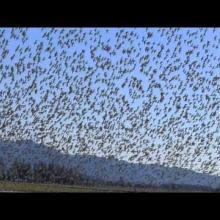

Join BirdNote tomorrow, November 30th!
Illustrator David Sibley and actor H. Jon Benjamin will face off in the bird illustration battle of the century during BirdNote's Year-end Celebration and Auction!
Along the coast of Sinaloa in México, there are species of shorebirds with one of the longest migrations in the Western Hemisphere. One such species is the Western Sandpiper, here known as el playerito occidental, wants to eat. But wetland habitats where they find their food are affected by the shrimp farming industry. Juanita Fonseca works with the Western Hemisphere Shorebird Reserve Network and with Manomet, creating guidelines that help shrimp farmers share the coastline with shorebirds.
Listen to this episode in Spanish here.
BirdNote®
The Western Sandpiper’s Winter Migration
Written by Camilo Garzón
This is BirdNote.
[Sinaloa tidal mudflat, Xeno Canto 518559]
Along the coast of Sinaloa in México, there are species of shorebirds with one of the longest migrations in the Western Hemisphere.
[Western Sandpiper calls, Xeno Canto 623973]
Juanita Fonseca: Se reproducen en Canadá y llegan a las costas de Sinaloa a estos sitios de granjas de camarón. El número es muy, muy abundantes.
They breed in Canada and arrive at the coasts of Sinaloa to spend the winter, says a Shrimp and Shorebird Conservation Specialist named Juanita Fonseca. Sinaloa has more than 400 miles of coastline in the Pacific Coast and the Sea of Cortés. There, Juanita works with the Western Hemisphere Shorebird Reserve Network and with Manomet, creating guidelines that help shrimp farmers share the coastline with shorebirds.
One of those shorebirds is the Western Sandpiper.
[Western Sandpiper calls, Xeno Canto 623972]
And the sandpiper, here known as el Playerito occidental, wants to eat. But their wetland habitats are affected by the shrimp farming industry.
Because of this, Juanita and other researchers want to see how and where these shorebirds travel, to learn which habitats need more protection. So they’ve placed lightweight radio transmitters on the birds to keep track of their movements.
Juanita Fonseca: Es una especie de interés para los canadienses, con lo cual nosotros hemos colaborado con ellos y trabajado con esta especie por el número que llega llega aca a estas costas.
It’s a species of interest for Canadian biologists, who collaborate with Juanita and her team to preserve their wintering grounds in Sinaloa, she is saying. And they do so by creating spaces within shrimp farms for the playerito to eat.
This show is part of a series on Manomet's shorebird conservation research, and it's also available en español — visit our website, BirdNote dot org, to learn more. I'm Camilo Garzón.
###
Senior Producer: Mark Bramhill
Producer: Sam Johnson
Managing Editor: Jazzi Johnson
Content Director: Jonese Franklin
Script Editor: Camila Kerwin from the Rough Cut Collective
Bird sounds provided by The Macaulay Library of Natural Sounds at the Cornell Lab of Ornithology, Ithaca, New York. Soundscape Xeno Canto 518559, Western Sandpiper XC623972, and Western Sandpiper XC623973 recorded by M. Grosselet.
BirdNote’s theme was composed and played by Nancy Rumbel and John Kessler.
© 2022 BirdNote September 2022 December 2024
Narrator: Camilo Garzón
ID# manomet-03-2022-09-20 manomet-03



